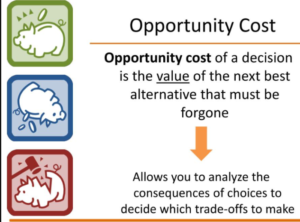 It started as a discussion about free tram rides in the Melbourne CBD in Victoria, Australia.
It started as a discussion about free tram rides in the Melbourne CBD in Victoria, Australia.
Could the revenue foregone be better used to invest in public transport improvements?
Are free tram rides in the CBD the best use of scarce resources?
Opportunity Cost, Benefit or Cost Benefit take an operator’s perspective that the cost-benefit of the free tram zone exceeds the benefits of revenue foregone from passengers paying fares. Transport specialists take a community perspective and conclude that the opportunity cost of ‘free’ tram rides is high & there are better ways to spend scarce public transport funding.
Free travel in the Melbourne CBD is an illusion. The opportunity cost to the public transport network across Victoria is real and measurable in revenue foregone!
Is it good government to provide free tram rides for public transport users in Melbourne’s CBD while outer suburban buses typically run only every 40 minutes on weekdays and hourly or not at all on weekends and evenings?
It is easier to justify anything we want when we don’t consider the alternatives. When we don’t question whether greater value is possible from other options e.g., is a paid Netflix subscription better value when SBS OnDemand and ABC iview stream quality programs at no direct cost to the viewer?
Opportunity Cost is the potential benefit foregone by choosing one alternative over another. It is an important, yet often overlooked consideration, when funds are scarce and change is ongoing.
A Cost-Benefit analysis measures the benefits, associated costs, and tangible outcomes of a proposal while also noting intangible outcomes. When the analysis confirms more benefit than costs, the proposal deserves further consideration against other business priorities and the cost-benefit of competing proposals.
Post-pandemic, the opportunity cost of perpetuating the past can threaten the future. Quantifying the cost-benefit of current practices, against other alternative opportunities, informs decision-making for future success.
Cost management, with a revenue focus, reviews both revenue and expenditure to identify unrealised opportunities and quantify the opportunity cost of perpetuating old business practices against options to deliver better value.
A recent analysis of an organisation in deficit estimated current revenue is just 62% of potential revenue. That is, perpetuating current business practices creates a revenue opportunity cost of 38% and a deficit!
It is not sustainable for a business with a $5,000,000 annual turnover to forego revenue of $1,900,000 when it is in deficit and has few reserves. The insolvency risk can be overcome by recognising the opportunity cost of current practices and achieving higher cost/benefit from alternative options.
Few systems achieve 100% of capacity. Even if 80% of total revenue was received, the additional $900k creates a surplus reducing reliance on an overdraft. Do you own calculations for $15m, $25m & $50m annual turnover.
Options to increase revenue to more than 80% of total potential include better use of customer relationship marketing (CRM) software, automated target marketing, a pricing review and documenting unwritten policies impacting revenue. Options which should all be the subject to a cost/benefit analysis.
Additional benefits can be achieved by applying cost management strategies and tactics to minimise waste, reduce duplication, manage variance, obtain ‘best value’ in supply, and embrace digital transformation. A target 5% reduction in cost adds an additional $260,000 in revenue to transition the organisation from deficit to being able to control its own destiny.
Opportunity cost is often unseen and therefore easily overlooked and is often highest when ‘business as usual’ funnels scarce dollars into projects, staff, or operations delivering insufficient return e.g., an outdated base roster with too many or not enough people in vital positions at vital times, manual processes which are better automated, and paying too much for supply when the same or better quality is available at a lesser cost.
Opportunity cost mirrors conflict of interest in that, the closer you get to it, the harder it can be to see. The vital question for every business is whether scarce resources are funding projects/staff/tasks which perpetuate the past at the opportunity cost of improved financial performance.
Is the opportunity cost of ‘business as usual’ limiting achievement of the cost-benefit of options that make more possible by increasing cashflow and profit?
What is the process in your business to redirect scarce funds to deliver a higher return?
A realist buys value to maximise their return from scarce resources. Covid restrictions taught us how quickly scarce resources become scarcer. Oscar Wilde said:
“A cynic knows the cost of everything and the value of nothing.”
Benefit from ‘cost management eyes’ and a revenue focus to identify how to achieve the cost/benefit of alternatives that reduce the opportunity cost of your ‘business as usual’.
Contact John Cleary on +61 411 522 521 for a confidential, no-obligation discussion on improving financial performance to make more possible in your business. www.costms.com.au
